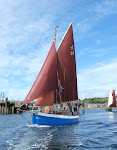After
an early morning walk round Portpatrick in bright warm sunshine we
ate breakfast sitting in Robinetta's cockpit and were ready to head
out of harbour by 0920. The faint breeze did not tempt us to raise
even the stay-sail at first, so we were under engine as I set the
course for the entrance to Strangford Lough.
By
1100 the breeze was about F2, so we raised sail with the no 1 jib. We
had to keep the engine on, or our speed dropped below 3 knots even
with tide assist, but at least we felt like a sailing boat. The 1110
Belfast weather forecast was a new one, issued, unusually, at 1000
UTC. It contained a strong
wind warning (occasional 6) for the area just South of us, and
NE 4-5 for us. There was no sign of it as we motor sailed south
in a light breeze.
We
lowered the main sail and furled the jib at 1145 since they were
doing nothing except getting a sun tan, but put them both back up at
1310 and sailed (with the engine off) at 3½ knots. Trying to get the
twist out of the throat halyard meant we lost a little throat tension
and the gaff saddle began to twist on the mast. We had to lower and
re-raise the main sail to get rid of the problem, and
the throat halyard still had a twist in it! We MUST get some good
rope on the throat halyard!
We
were on a very broad reach and rigged the preventer. We also had the
auto helm in use as the visibility was not good enough for a human
helmsman to keep on course easily. The blue sky was mostly covered by
cloud at 3, and without direct sun light the air felt much colder.
The wind also dropped, until we were doing less than 3 knots under
sail, and we put the engine back on at 1520. We got the main down
half an hour later, but
kept the stay-sail and jib. The wind did get up again later, but the
main stayed down; the swell increased and we tied the boom to a back
stay to stop it moving as Robinetta
rolled. The tiller pilot could not cope and I took the helm.
Julian
phoned the marina at Portaferry; it is only small and I was worried
that the marina office would be shut before we got there. The contact
number is a mobile, which is just as well since the harbour master
had it with him. It turns out that the marina is not open for the
season yet! However they promised to have someone there to meet us at
our ETA, and that the facilities would be open.
Julian
and I had been having an ongoing discussion all day. His Navionics
charts told him that the flood up Strangford Lough started at 6 pm
(based on tidal heights) while the pilot book and Reeds told me that
the flood began at 8pm. We reached the entrance just before 6, and
tried to go in under engine, staysail, and jib. The pilot book warned
of confused seas at the entrance during the ebb and they were right.
Robinetta
could not make progress against the tide, and Worm
was being pushed all over the place. After quarter of an hour we
gave up and turned away towards the safe water mark. As soon as we
tacked round we were away from the confusion in moments at over 6
knots.
We
turned the engine off, furled away the jib, and hung around just off
the entrance until 1915, when we tried again. This time, although we
were down to 2 knots as we passed the Pladdy cardinal, there was
nothing unusual about the sea state and we managed to get into the
narrows.
By
the time we reached the marina we were doing 6 knots, and had to
steer at 90°
to our course to make the
marina entrance. As soon as we were past the buoy the tidal stream
lost its grip, and we could steer normally again.
There
were no boats in the marina at all, but Padraig was there to show us
where to go, and Robinetta was safely moored up, with Worm hauled up onto
the pontoon, by 2045. A much more tiring day than yesterday, but we
were rewarded with a spectacular sunset for our troubles.
I
will take this as a lesson to trust the pilot, and Reeds, over the
Navionics charts for tidal streams in Ireland!






No comments:
Post a Comment